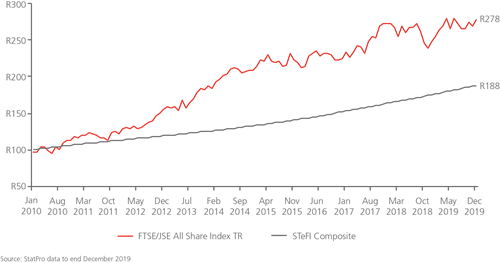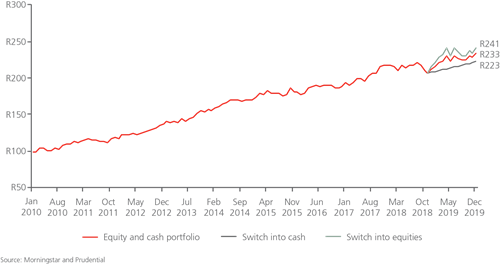Buying more: An alternative approach to volatile markets
Issac Newton said it best when he coined the phrase: What goes up, must come down. Although this particular phrase has its roots embedded in science, there is a key insight here that can also be applied to investing - that as an investor you should expect the value of your investment to go up… and down… at some point in time.
The extent and frequency at which the value of your investment moves, however, will depend on a number of factors, such as market conditions and the asset classes that you’re invested in. To get to grips with how this all works, a good starting point is to understand the characteristics of your chosen asset classes – that way you’re less likely to be caught off-guard when you experience sharp and dramatic changes in value.
For example, equities are significantly more volatile than cash, which means that they will typically have bigger and more frequent swings in value over time. To demonstrate this, the graph below shows the value of a R100 investment in cash (STeFI Composite index) and equites (FTSE/JSE All Share index TR) over the past 10 years. Granted, comparing these two asset classes against each other is a bit like comparing chalk and cheese – in that their characteristics, objectives and potential return over the long term are very different – but for the sake of this exercise, it does highlight the differences in volatility quite effectively.

Knowing what to expect from an asset class that you’re invested in can dramatically influence how you behave during downcycles. Arguably, the most common mistake that investors make during periods of underperformance is to panic and switch out of their investments, thereby locking in their losses and eroding their investment returns, when the safest course of action is to simply do nothing at all and ride out the ebbs and flows. This understandably is a lot easier said than done, but if you have mentally and emotionally prepared yourself for the inevitable – that at some point your investment will go through a period of underperformance – it becomes a lot easier to behave rationally and not to sell or switch when the time comes.
There is, however, another option that investors can take when markets are down – and that is to buy more! While this may sound counterintuitive, especially given that it’s human nature to steer away from the very thing that is causing you distress, from a logical perspective it can sometimes make good financial sense to buy assets when they are trading at a discount.
To demonstrate this concept, the graph below shows the value of a R100 investment split equally between cash (STeFI Composite index) and equities (FTSE/JSE All Share index TR), but with the inclusion of three different outcomes based on investors choosing to either:
- Switch the equity portion of their portfolio into cash at the point where equities experienced their biggest three-month decline in 10 years (-12.6% between September – November 2018); or
- Buy more equities by switching the cash portion of their portfolio into equities; or
- Continue with the portfolio as-is and simply do nothing.

As you can see, holding or buying more equites produced better outcomes than you would have experienced had you sold or switched out of your investment and into cash.
The challenge, however, is knowing when to buy more. You don’t want to be caught buying assets when there is a sound reason for avoiding them. This is where it becomes important to choose a fund manager that you not only trust, but you also have conviction in their investment process, philosophy and track record. Most fund managers will give you a good indication of whether markets are undervalued in their quarterly reportbacks. If they seem optimistic about future returns, then so should you. One of the great parts about using a fund manager that you trust is that it takes the guesswork out of knowing which assets to buy. You can simply top up your existing investments so that your chosen fund manager selects the underlying assets on your behalf. To find out which Prudential fund suits your investment needs, try our Fund Selector Tool on our website, or visit the Our Funds section to see our full range of local and offshore funds.
While it might be challenging to ignore the impulse to “run” when market performance is difficult and volatile, as has been the case over the past 4-5 years, it’s important to remember that there may be an opportunity to purchase assets at a discount. The trick is to not act out of emotion, but rather with a well-researched and measured approach. And when in doubt, speak to your financial adviser who will be able to help guide your investment decisions.
To find out more about our views on prospective asset class returns and other economic news and fund updates, visit the Insights section of our website. Alternatively, for more information, contact our Client Services Team on 0860 105 775 or email us at query@prudential.co.za.
Share
Did you enjoy this article?
 South Africa
South Africa Namibia
Namibia




 Get the Newsletter
Get the Newsletter